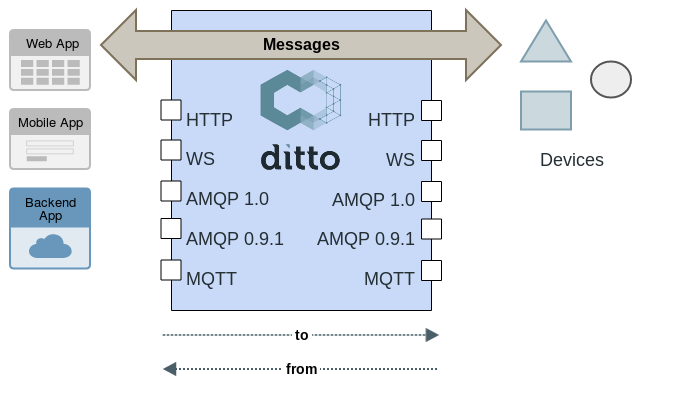Messages do not affect the state of a digital twin or an actual device. Therefore Ditto does not handle messages like commands: there are no responses which are produced by Ditto and no events which are emitted for messages.
Messages provide the possibility to send something to or from an actual device using an arbitrary subject/topic. They contain a custom payload with a custom content-type, so you can choose what content best fits your solution.
Expressed differently, Messages
- to devices are operations which should trigger an action on a device (e.g. with a subject
turnOff), - from devices are events/alarms which are emitted by devices (e.g. with a subject
smokeDetected).

Characteristics of Messages
Eclipse Ditto is not a message broker and does not want to offer features a message broker does.
It can be seen as a message router which:
- accepts messages via 2 APIs (HTTP and Ditto Protocol, e.g. via WebSocket binding)
- checks for currently connected interested parties whether they may receive a specific Message (performs authorization checks)
-
routes the Message and reply Messages in between connected clients
Warning: Ditto offers no message retention. If a device isn’t connected when a Message should be routed, it will never receive the Message.Warning: Ditto makes no statement about Message QoS. Messages are routed at most once.Warning: Ditto does deliver messages only in “fan out” style, if the same credentials are connected twice, both connections will receive Messages if the credential is authorized to read a Message.
Elements
Ditto messages always have to have at least this elements:
- Direction: to / from,
- Thing ID: the ID of the
Thing(actual device) which should receive/send the message and - Subject: the custom subject/topic.
Additionally they can contain more information:
- Feature ID: if a message should be addressed to the Feature of a Thing, this specifies its ID.
- content-type: defines which content-type the optional payload has.
- correlation-id: Ditto can route message responses back to the issuer of a message. Therefore a correlation-id has to be present in the message.
Payload
A message can optionally contain a payload. As Ditto does neither have to understand the message nor its payload, the content-type and serialization is arbitrary.
APIs
Messages can be sent via
- the WebSocket API as Ditto Protocol messages,
- the HTTP API either as “fire and forget” messages or, when expecting a response, in a blocking way at the Messages HTTP API endpoint
Messages can, however, be received only via the WebSocket API as Ditto Protocol messages.
Receiving Messages
To be able to receive Messages for a Thing, you need to have READ access on that Thing.
When a Message is sent to or from a Thing, every connected WebSocket with the correct
access rights will receive the Message. If there is more than one response, only the
first one will be routed back to the initial issuer of a Message.
Sending Messages
If you want to send a Message to or from a Thing, you need WRITE permissions on that Thing.
Every WebSocket that is able to receive Messages for the Thing (READ permission), will receive your message.
Responding to Messages
Since WebSocket messages are stateless there is no direct response to a Message.
For Ditto to be able to route the response of a Message back to the issuer, the
correlation-ids need to match. E.g. when the sender uses correlation-id random-aa98s,
any receiver can reply by using the same correlation-id random-aa98s.
Permissions
API version 1
Permissions in API version 1 are simple for the Message API. If you want to receive Messages of a Thing,
you need READ access on the Thing. To be able to send Messages to or from a Thing
you need to have WRITE permissions.
There is one sole exception, which are Claim Messages. You do not need access rights for sending them.
API version 2
Permissions in API version 2 can be more fine grained. In order to be able to receive all Messages of a Thing,
you need READ permission for the message:/ resource in the used Policy.
There can however be specified that you may only receive specific Messages (with a defined subject), also
expressed via Policy entry.
The same applies for being able to send Messages, here a WRITE permission is required either globally for
all messages via the message:/ resource or only for specific ones.
There is one sole exception, which are Claim Messages. You do not need access rights for sending them.
Claim Messages
A Claim Message is used to gain access to a Thing. For this purpose a Claim Messages has two specifics:
- the predefined message subject is always claim
- you do not require
WRITEpermission to send a Claim Message
Apart from that the Claim Message is handled like a standard Message. It is forwarded to all Ditto Protocol bindings that registered for Claim Messages of the specific Thing. The decision whether to grant access (by setting permissions) is completely up to the receiver of the Claim Message e.g. after verifying the payload of the Message.